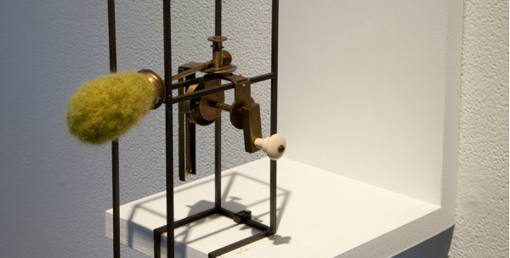Eskimo Kisses
Posted on October 25, 2012 | posted by:Gary Schott, metals department chair of the Southwest School of Art, creates mechanized objects to produce interactive moments. ‘Eskimo Kisses’ is a mechanism with a small crank handle that is connected to a simple system of gears and rivets. They turn out the gentle wiggling movement of a felt wad that gently rubs the nose of its user. For me, the mechanics and the poetics of this piece resemble a dichotomy in design. What Schott does so elegantly is balances the two.
Eskimo Kisses : Design
Mechanisms : Design Methods
Poetics : Human-Centered Motivations
Schott’s work exercises the technical metalsmithing skills he has accumulated and uses it to create very mechanical objects with poetic outcomes. The research methods designers learn to use early on such as diagramming, workshopping, brainstorming, etc., are mechanisms or procedures for obtaining information. Because of the formulaic nature of some of the research methods we use, we sometimes calculate our way through understanding people while there is much more happening. What are the quiet, unconscious undertones running within this person? What is the relationship between them and others? What does that then mean to us? We often overlook how necessary it is to interrogate behaviors, i.e., poetics, while using these methods.
Now, can taking a more intimate look and de-methodizing be turned in to a method itself? How can this become a well-constructed tool for us to use? The possibilities here are exciting. By employing such introspective methods, the array of outcomes we produce have the potential to address the psychology of our behaviors. We can mimic the mechanical process of Eskimo Kisses but still maintain the balance with poetics as we design. As Transdisciplinary Designers from remarkably diverse backgrounds, this should be our universal language.
This may seem trivial to consider while urgent needs and large systems require attention. The personally most resonant statement of Sigmund Freud I have come across illustrates the importance in examining the small things. “Let us not under-value small signs: Perhaps from them it may be possible to come upon the tracks of greater things… And then, if one may, with good fortune and virtue of the interrelationship linking each thing to every other (hence, also, the small to the great), find, even in the course of such humble labour, a road to the study of the great problems.”
Authored by Doremy Diatta
Photo Credit to http://www.garyschott.com/
